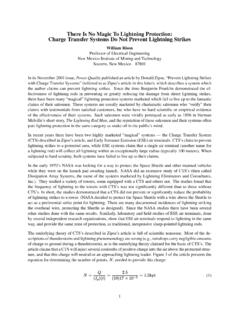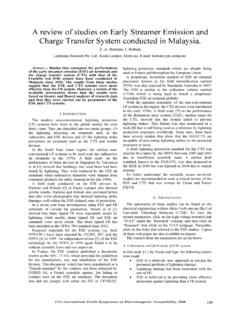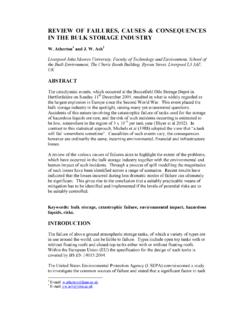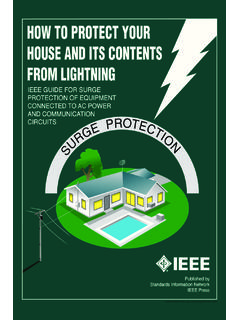Transcription of Open Access Lightning Discharge and …
1 Journal of Lightning Research, 2012, 4, (Suppl 1: M2) 3-11 3 1652-8034/12 2012 Bentham Open Open Access Lightning Discharge and fundamentals of Lightning Protection Vladimir A. Rakov* Department of Electrical & Computer Engineering, University of Florida, Gainesville, FL, USA Abstract: A review of Lightning protection concepts introduced by Benjamin Franklin (18th century) and James Clerk Maxwell (19th century) is given. Modern approaches to Lightning protection of various structures and systems are discussed. In particular, the widely used electrogeometrical model (one version of which is the Rolling Sphere Method) and the topological shielding are presented. Bonding requirements, needed to avoid side flashes (in air or in the soil), are discussed. Lightning parameters important for Lightning protection are reviewed. Keywords: Lightning parameters, structural Lightning protection, electrogeometrical method, rolling sphere method, bonding.
2 1. GENERAL PRINCIPLES Systematic studies of thunderstorm electricity can be traced back to May 10, 1752 in the village of Marly-la-Ville, near Paris. On that day, in the presence of a nearby storm, a retired French dragoon, acting on instructions from Thomas-Francois Dalibard, drew sparks from a tall iron rod that was insulated from ground by wine bottles. The results of this experiment, proposed by Benjamin Franklin, provided the first direct proof that thunderclouds contain electricity. Even before the experiment at Marly, Franklin had proposed the use of grounded rods for Lightning protection. Originally, he thought that the Lightning rod would silently Discharge a thundercloud and thereby would prevent the initiation of Lightning . Later, Franklin stated that the Lightning rod had a dual purpose: if it cannot prevent the occurrence of Lightning , it offers a preferred attachment point for Lightning and then a safe path for the Lightning current to ground.
3 It is in the latter manner that Lightning rods, often referred to as Franklin rods, actually work. There are generally two aspects of Lightning protection design: 1) diversion and shielding, primarily intended for structural protection but also serving to reduce the Lightning electric and magnetic fields within the structure, and 2) the limiting of currents and voltages on electronic, power, and communication systems via surge protection. Primarily the first aspect will be considered here. Properly designed structural Lightning protection systems for ground-based structures serve to provide Lightning attachment points and paths for the Lightning current to follow from the attachment points into the ground without harm to the protected structure. Such systems are basically composed of three elements: 1) air terminals at appropriate points on the structure to intercept the Lightning , 2) down conductors to carry the Lightning current from the air terminals toward the ground, and 3) grounding electrodes to pass the Lightning current into the earth.
4 The three system components must be electrically well connected. The efficacy of this so-called conventional approach to Lightning protection has been well *Address correspondence to this author at the Department of Electrical & Computer Engineering, University of Florida, Gainesville, FL 32611-6130, USA ; Tel: 352-392-4242; E-mail: demonstrated in practice. Neither data nor theory supports claims that non-conventional approaches, including Lightning elimination and early streamer emission techniques, are superior to the conventional one. Lightning protection system for houses proposed in 1778 is shown in Fig. (1). Modern structural Lightning protection is illustrated in Fig. (2). Note that metallic roofs whose thickness is mm (3/16 in.) or greater do not require air terminals (NFPA 780 [3]). Fig. (1). Lightning protection system for houses proposed (most likely by G.)
5 Ch. Lichtenberg) in 1778. Adapted from Wiesinger and Zischank (1995) [1]. In 1876, James Clerk Maxwell suggested that Franklin rod systems attracted more Lightning strikes than the surrounding area. He proposed that a gunpowder building be completely enclosed with metal of sufficient thickness, forming what is now referred to as a Faraday cage. If Lightning were to strike a metal-enclosed building, the current would be constrained to the exterior of the metal enclosure, and it would not even be necessary to ground this enclosure. In the latter case, the Lightning would merely produce an arc from the enclosure to earth. The Faraday cage effect is provided by all-metal cars and airplanes. Modern steel-frame buildings with reinforcing metal bars in the concrete foundation connected to the building steel provide a good approximation to a Faraday cage.
6 As the spacing between conductors increases, however, the efficiency of the 4 Journal of Lightning Research, 2012, Volume 4 Vladimir A. Rakov Lightning protection decreases. In practice, a combination of the Franklin rod system concept and the Faraday cage concept is often used. Modern Lightning protection schemes for structures containing computers or other sensitive electronics employ a technique known as topological shielding with surge suppression (see Fig. 3), which can be viewed as a generalization of the Faraday cage concept. Fig. (3). The general principles of topological shielding. Adapted from Vance (1980) [4]. 2. Lightning PARAMETERS IMPORTANT FOR Lightning PROTECTION Lightning Parameters vs Damage Mechanisms The type and amount of Lightning damage that an object suffers depends on both the characteristics of the Lightning Discharge and the properties of the object.
7 The physical characteristics of Lightning of most interest are various properties of the current waveform and of the radio frequency electromagnetic fields. Four distinct properties of the Lightning current waveform are considered important in producing damage: 1) the peak current, 2) the maximum rate of change of current, 3) the integral of the current over time ( , the charge transferred), and 4) the integral of the current squared over time, the "action integral". We now briefly examine each of these properties and the type of damage to which they are thought to be related (Rakov and Uman, 2003 [5]). 1) Peak current. For objects or systems that present an essentially resistive impedance, such as, under certain conditions, a ground rod driven into the earth, a long power line, and a tree, the voltage (V) on the object or system with respect to remote ground will be proportional to the current, I, via Ohm's law, V = RI, where R is the effective resistance at the strike point.
8 For example, a 30 kA peak current injected into a power line phase conductor with a 400 characteristic impedance (effective resistance 200 since 400 is "seen" in each direction) produces a line voltage of 6 MV with respect to the earth. Such a large voltage can lead to an electric Discharge from the struck phase conductor to adjacent phase or neutral conductors or to ground across insulating materials or through the air. 2) Maximum rate-of-change of current. For objects that present an essentially inductive impedance, such as, under some circumstances, wires in an electronic system, the peak voltage will be proportional to the maximum rate-of-change of the Lightning current (V = L dI/dt, where L is the inductance of the length of wire and V is the voltage difference between the two ends of the wire).
9 For example, if a ground wire connecting two electronic systems (for example, in a communications tower and in an adjacent electronics building) has an inductance per unit length of 10-6 H m-1 Fig. (2). Modern structural Lightning protection (UL 96A, figure , 1998) [2]. Lightning Discharge and fundamentals of Lightning Protection Journal of Lightning Research, 2012, Volume 4 5 and if 10 percent of the direct Lightning current flows in the wire producing dI/dt = 1010 A s-1, 10 kV will be produced across each meter of the wire. It is easy to understand how even a very small fraction of the Lightning current circulating in grounding and bonding wires can cause damage to solid-state electronic circuits that have communication, power and other inputs grounded at different locations. 3) Integral of the current over time. The severity of heating or burn-through of metal sheets such as airplane wing surfaces and metal roofs is, to a first approximation, proportional to the Lightning charge transferred which is in turn proportional to the energy delivered to the surface.
10 This is the case because the input power to the conductor surface is the product of the current and the more or less current-independent voltage drop at the arc-metal interface, this voltage drop being typically 5 to 10 V. The voltage drop at the interface can be thought of as a contact potential between the two materials or the difference in the work functions of the two materials, although the situation is considerably more complex than the case of two contiguous solid conductors in that the metal surface is partially melted and the air arc contains metal vapor. Generally, large charge transfers are due to long-duration (tens to hundreds of milliseconds) Lightning currents, such as long continuing currents, whose magnitude is in the 100- to 1,000-A range, rather than return strokes having larger currents but relatively short duration and hence producing relatively small charge transfers.











